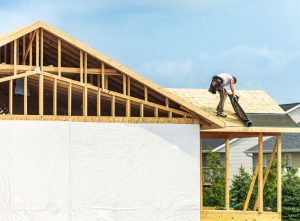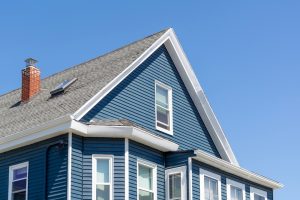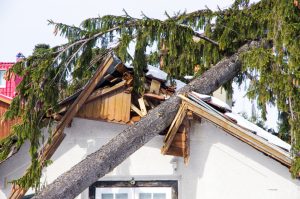A Clear Guide to Roofing Underlayment Pricing
When Edgewater homeowners begin planning a roofing project, understanding the role and cost of roofing underlayment, including when to replace underlayment, is a crucial first step for effective homeowner budgeting and planning.
At Thunder Bay Roofing, co-owned by experienced Edgewater, MD, roofing contractors Nick Perz and Steven Friedman, we believe that transparent pricing and honest communication empower homeowners to make the best decisions for their property.
Learn more about the cost of roofing underlayment in Edgewater, MD, & surrounding areas by calling us at 410-956-7663 or reading the helpful guide below. We proudly serve Edgewater, Annapolis, Arnold, Bel Air, and surrounding areas with detailed roofing underlayment estimates and thoughtful material recommendations that reflect your goals and budget.
Why Choose Thunder Bay Roofing?
At Thunder Bay Roofing, our reputation is built on years of hands-on experience, craftsmanship, and a deep commitment to the communities we serve. Co-owners Nick Perz and Steven Friedman bring decades of combined roofing skills to every job, ensuring that each project is completed with precision, care, and full code compliance. Our team is trained to handle everything from simple roofing underlayment replacements to complex roofing systems for homes with steep pitches and intricate architecture.
Whether we’re working on a family home near Annapolis or updating a roof in Edgewater with views of the South River, we treat every property with the same level of professionalism and detail. When you choose Thunder Bay Roofing, you’re choosing a local team that knows the challenges of Maryland weather and how to build roofing systems that last. Call us at 410-956-7663 to book your consultation or learn more.
Key Factors That Shape The Costs of Roofing Underlayment
There is no one-size-fits-all answer to underlayment pricing because several important factors come into play. The roof type and the overall roofing system design are major factors in underlayment costs, as different roof types and system complexities require specific materials and installation methods. Understanding what affects the cost will help you create a more accurate budget and choose the best materials for your home.
Roof Size and Surface Area
The size of your roof is one of the biggest contributors to your overall project cost. Roofing materials, including underlayment, are priced by the square foot. Larger roofs naturally require more material and labor, but they also tend to benefit from bulk pricing and installation efficiency, which can help reduce the cost per square foot.
Type of Roofing Underlayment Material
Your choice of material will significantly impact the final price. Traditional asphalt felt, also known as asphalt-saturated felt, is the most affordable option and is commonly used as roofing felt, roofing felt paper, and felt paper. These materials are made from absorbent paper coated in asphalt, providing a water-resistant but less durable layer than modern alternatives.
Asphalt roofing felt and tar paper are both cost-effective, with tar paper being a traditional, asphalt-impregnated felt that extends roof durability and weather resistance. Felt paper and tar paper are similar in composition and are valued for their economical price, though they have limitations in durability.
Roof Complexity and Design Features
If your roof has a complex layout with multiple valleys, dormers, skylights, or a steep roof pitch, it will take longer to install roofing underlayment correctly. These architectural features require additional cutting, overlapping, and fastening, which increases material waste and labor time. The more complicated the roof design, especially with complex or steep roofs, the higher the cost of your roofing underlayment due to higher labor costs.
Geographic Location
Roofing underlayment costs can vary based on regional pricing trends, material availability, and local building codes, making a cost comparison essential. For example, homes near the Maryland coastline may require specific moisture-resistant underlayment types due to increased humidity and salt exposure, which can increase the overall project cost.
Seasonal Demand
Roofing is a seasonal industry, with peak demand typically occurring in spring and fall. Scheduling your project during off-peak months may help reduce costs, but weather conditions must be considered to ensure safe and effective installation of roofing underlayment.
How We Compare in the Local Market
Honest Pricing in the Annapolis Area
Thunder Bay Roofing’s prices reflect fair market rates for the Edgewater and Annapolis region, considering current material prices. Our estimates for different underlayment materials typically fall within 10 percent of other quality contractors, but we offer better warranty protection and local accountability.
We encourage you to get multiple quotes—just don’t choose based on the lowest price alone. Installation quality makes a huge difference in how long your underlayment lasts and how well it protects your home.
Why We Can Keep Costs Reasonable
We work with multiple suppliers to ensure we always have materials available at competitive prices. By sourcing locally when possible, we reduce delivery costs, support Maryland businesses, and ensure faster project completion. If you ever need warranty work, replacement parts are readily available.
Cost Breakdown: Felt Roofing Underlayment
Asphalt felt roofing underlayment remains a popular budget-friendly option. It’s available in two common grades: 15-pound and 30-pound, each offering different durability and water resistance. Some roofs, especially those with low slopes, require two layers of felt for adequate protection and waterproofing.
When installing asphalt roofing felt, the number of layers of felt may vary depending on the roof type and slope to ensure proper performance and durability.
15-Pound Felt
This lightweight underlayment costs between $0.25 and $0.50 per square foot for materials alone. It offers basic moisture protection and is often used in milder climates or on roofs with lower risk exposure.
30-Pound Felt
This thicker version offers improved durability and is more resistant to tears and leaks. Material costs generally fall between $0.35 and $0.65 per square foot, making it a modestly priced upgrade over 15-pound felt.
Installation Labor Costs
Professional installation of felt underlayment usually ranges from $0.50 to $1.00 per square foot, depending on roof slope, layout, and the experience level of the contractor. Proper installation is essential for achieving a secure, long-lasting barrier.
Total Installed Cost
Homeowners can expect total felt underlayment costs to fall between $1.10 and $2.15 per square foot. For a roof measuring 2,000 square feet, this equates to a total investment of approximately $2,200 to $4,300.
Additional Expenses to Consider
Removing old roofing material, repairing the roof deck, and disposing of debris can add 10 to 20% to the total cost. At Thunder Bay Roofing, we include these elements in your estimate to ensure there are no surprise charges down the road.
Costs of Synthetic Underlayment
Long-Term Performance That Justifies the Price
Synthetic underlayments have become a preferred option for many homeowners due to their enhanced strength, durability, and moisture resistance, especially when considering the installation of new underlayment. Synthetic underlayment materials are also lighter and easier to handle, which can reduce labor time.
Premium Synthetic Materials
High-performance synthetic underlayments typically cost between $0.75 and $1.50 per square foot. These products are designed to withstand heavy winds, UV exposure, and extreme temperatures, offering superior protection and long-term reliability.
Mid-Range Synthetic Options
Mid-grade synthetic underlayment materials offer a balance between performance and affordability, usually priced between $0.50 and $1.00 per square foot. They’re popular for homeowners who want better protection than felt without paying for top-tier materials.
Labor Efficiency
Synthetic underlayment is easier to roll out and secure than felt, which often lowers labor costs. In many cases, the roofing underlayment installation process is quicker and requires fewer fasteners, which helps offset the higher material cost.
Total Installed Cost
Homeowners can expect to pay between $1.75 and $3.50 per square foot for a fully installed synthetic underlayment. On a standard 2,000 square foot roof, this equals a range of approximately $3,500 to $7,000.
Return on Investment
Synthetic underlayments typically last 25 to 30 years, compared to the 10 to 15-year lifespan of felt. Over time, this longer service life means fewer replacements, less maintenance, and better overall value.
High-End Materials: Rubberized and Peel-and-Stick Membranes
Best for Maximum Protection in Harsh Conditions
Rubberized asphalt and peel-and-stick membranes represent the most advanced and durable forms of roofing underlayment available. These materials are designed for critical areas of your roof and provide unmatched waterproofing.
Rubberized Asphalt
Rubberized asphalt underlayments cost between $1.50 and $3.00 per square foot. These roofing underlayment materials are self-sealing and form a watertight barrier, making them ideal for cold climates or areas prone to ice dams.
Peel-and-Stick Membranes
Top-of-the-line peel-and-stick membranes typically range from $2.00 to $4.00 per square foot. They offer complete waterproofing and are often used in valleys, roof edges, and other high-risk areas.
Installation Considerations
These products often require precise surface preparation and temperature-sensitive handling, which can increase labor costs. However, the investment is well worth it for homes that require maximum protection.
Total Cost
Full installation of high-end underlayments typically ranges from $3.50 to $7.00 per square foot, depending on product type and the size of the application area.
Roofing Underlayment Cost by Roof Size
Understand the Scale of Your Investment
Your total underlayment cost will scale with the size of your roof. Larger roofs generally result in higher overall costs but lower prices per square foot.
Small Roofs (1,000–1,500 sq. ft.)
- Felt: $1,500–$4,500
- Synthetic: $2,500–$7,500
Medium Roofs (1,500–2,500 sq. ft.)
- Felt: $2,200–$6,500
- Synthetic: $3,500–$10,500
Large Roofs (2,500+ sq. ft.)
- Felt: $3,500–$12,000
- Synthetic: $5,500–$18,000
Extra Costs and Things to Watch For
Even with a clear estimate, it’s important to be aware of potential add-on costs that may arise. In some cases, project expenses can be a bit higher due to unique circumstances such as material thickness, regional labor variations, or specific roofing requirements.
- Deck Repairs: $2–$8 per sq. ft. if your roof decking is damaged.
- Permits and Inspections: $100–$500, depending on your town.
- Waste Disposal: Adds five to10% to your total project cost.
- Weather Delays: May require protective coverings or rescheduling.
- Warranty Plans: Add value and peace of mind for a modest additional cost.
How to Keep Costs Under Control
- Schedule Smart: Off-season installations may come with discounts.
- Choose Wisely: We’ll help you pick materials that match your budget and performance needs.
- Use Premium Materials Strategically: Focus on high-risk areas.
- Bundle Work: Combine underlayment installation with shingle replacement or roof repairs for savings.
- Ask About Financing: Thunder Bay Roofing offers flexible financing to make projects more manageable.
What Maryland Building Codes Require
Know Your Local Requirements
Maryland has specific rules for roofing underlayment that depend on where you live and your roof’s design. If your home is within 3,000 feet of the Chesapeake Bay or Atlantic Ocean, you’ll need stronger moisture protection because of salt air and extra humidity.
Homes with low-slope roofs (less than 4:12 pitch) must use self-sticking membranes in problem areas. Steeper roofs can typically use standard felt or synthetic materials.
What Works Best in Maryland Weather
Maryland’s climate brings hot, humid summers and unpredictable winters. This creates real challenges for your roof. Synthetic underlayments work great here because they don’t soak up moisture or expand and contract with temperature changes.
How We Install Your Underlayment Right
Getting the Details Right
Good underlayment installation isn’t just about rolling out material. Using proper techniques when installing underlayment is crucial for long-term roof performance. There are specific rules we follow:
- Horizontal seams overlap at least 2 inches
- Vertical seams overlap 6 inches minimum
- Fasteners go in every 6-8 inches along the edges
- Field areas get fasteners every 12 inches
- Valleys need extra care—underlayment extends 18 inches on each side
Emergency Work and Tricky Roofs Cost More
Storm Damage Means Higher Prices
When a storm damages your roof and you need emergency underlayment replacement, expect to pay 15-25 percent more than normal. Why? Materials are harder to get, timelines are urgent, and we often need temporary protection while sourcing materials.
Challenging Roofs Add to the Bill
Some roofs are just harder to work on:
- Steep roofs (over 8:12 slope): Add $0.25-$0.75 per sq ft for safety equipment
- Multi-story homes: May need special access equipment
- Limited vehicle access: Could require crane delivery
- These challenges can add $500-$2,000 to your project cost
The good news? We’ll identify these issues upfront so there are no surprises in your final bill.
Taking Care of Your investment
What Maintenance Do You Need?
The amount of upkeep depends on what type of underlayment you choose:
- Felt: Check it visually every year, especially after storms, for tears or areas that have shifted
- Synthetic and Rubberized: Almost no maintenance needed, but have a professional look every 3-five years during regular roof maintenance.
For all types, keep your gutters clean and make sure your attic has good ventilation. This prevents moisture buildup that can damage any underlayment over time.
Warning Signs Something’s Wrong
Keep an eye out for these red flags:
- Water stains in your attic
- Ice dams are forming on your roof
- Missing or damaged shingles
- Musty smells that might mean water problems
- Lots of granules in your gutters
- Sagging areas between the roof supports
- Daylight showing through your roof boards
If you notice any of these, call for a professional inspection right away.
Warranty Protection That Matters
What Coverage Can You Expect?
Different materials come with different warranty protection:
- Felt: Usually 10-15 years from the manufacturer
- Premium Synthetic: Often 25-30 years of coverage
- Rubberized and Peel-and-Stick: May offer up to 40 years
Thunder Bay Roofing adds our own workmanship warranty on top of manufacturer coverage. Depending on your material choice and project scope, we provide 5-10 years of additional protection.
Real Benefits Beyond the Roof
Quality underlayment does more than just protect your home:
- Insurance Discounts: Many Maryland insurers offer 5-15% discounts for upgraded roofing systems
- Energy Savings: Reflective underlayments can cut cooling costs by 8-12% each year
- Home Value: Quality roofing typically adds 3-5% to your home’s resale value
These benefits often pay for the upgrade cost over time.



